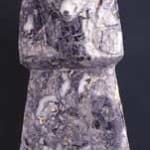Atlantic Watershed Stone Bird-Celt, 300 BCE - 500 CE
Stone
7
PF.4017
In the context of Pre-Columbian art and archaeology, jade is a generic term that refers to any variety of hard, dense stones that were worked with great skill by native...
In the context of Pre-Columbian art and archaeology, jade is a generic term that refers to any variety of hard, dense stones that were worked with great skill by native artists. Although jade is generally thought to be green, it can actually be a range of colors. Jade carving flourished in ancient Costa Rica for over a thousand years, roughly from 500 B.C. to 900 A.D., although the period of greatest artistic accomplishment lasted from 300 to 700 A.D. It is believed that jade working began during an extended period of agricultural abundance that allowed the ancient society to dedicate part of its energies toward the cultivation of artistic pursuits.
Jade was considered to be a sacred material by the ancient populations of Costa Rica, held in even higher esteem than gold. Generally, it was thought to symbolize that vital life force that sustains us all. The color green is naturally associated with verdant plant life. Specifically, jade was thought to symbolize the sprouting maize plant, that staple of the Pre-Columbian diet. It has also been suggested that jade represents water. Either way, we can be certain that jade represented the very essence of life itself.
To date, no native sources of jade have been discovered in Costa Rica, suggesting an extended trade network existed that imported this precious resource from Mesoamerica into Costa Rica where it was carved by local artists. Such trade also would have brought great wealth and likely reinforced the social stratification of the peoples. Jade may have served as a status marker to distinguish the elite from the masses and solidify their hold on power. We can picture an ancient ruler or shaman presiding over a sacred ceremonial adorned in brilliant green jade pendants and jewelry. The ancient Costa Ricans believe that the system of social hierarchy also extended into the afterlife. Therefore, jade objects were buried with the elite so that their power could be maintained throughout eternity.
The bird-celt is an important and highly regarded piece in the Ancient Central American culture, and became a cult image as far back as the Olmec culture. Its meaning and symbolism are varied and its dense material is believed to have been imported from Guatemala in its raw state. The beautifully mottled gray stone, adds a distinct and rare quality to the piece, without distracting from the carvings and incisions made to create the character of the piece. The slight curvature of the piece increases its functionality while the size of the base evens out the entire composition. The head is in the style of a bird, distinctly showing the outline around the eyes, the large beak and the wings. As a whole, this functional object has also become a beautiful work of art, which can be admired and cherished by generations to come.
Jade was considered to be a sacred material by the ancient populations of Costa Rica, held in even higher esteem than gold. Generally, it was thought to symbolize that vital life force that sustains us all. The color green is naturally associated with verdant plant life. Specifically, jade was thought to symbolize the sprouting maize plant, that staple of the Pre-Columbian diet. It has also been suggested that jade represents water. Either way, we can be certain that jade represented the very essence of life itself.
To date, no native sources of jade have been discovered in Costa Rica, suggesting an extended trade network existed that imported this precious resource from Mesoamerica into Costa Rica where it was carved by local artists. Such trade also would have brought great wealth and likely reinforced the social stratification of the peoples. Jade may have served as a status marker to distinguish the elite from the masses and solidify their hold on power. We can picture an ancient ruler or shaman presiding over a sacred ceremonial adorned in brilliant green jade pendants and jewelry. The ancient Costa Ricans believe that the system of social hierarchy also extended into the afterlife. Therefore, jade objects were buried with the elite so that their power could be maintained throughout eternity.
The bird-celt is an important and highly regarded piece in the Ancient Central American culture, and became a cult image as far back as the Olmec culture. Its meaning and symbolism are varied and its dense material is believed to have been imported from Guatemala in its raw state. The beautifully mottled gray stone, adds a distinct and rare quality to the piece, without distracting from the carvings and incisions made to create the character of the piece. The slight curvature of the piece increases its functionality while the size of the base evens out the entire composition. The head is in the style of a bird, distinctly showing the outline around the eyes, the large beak and the wings. As a whole, this functional object has also become a beautiful work of art, which can be admired and cherished by generations to come.
Literature
V24



